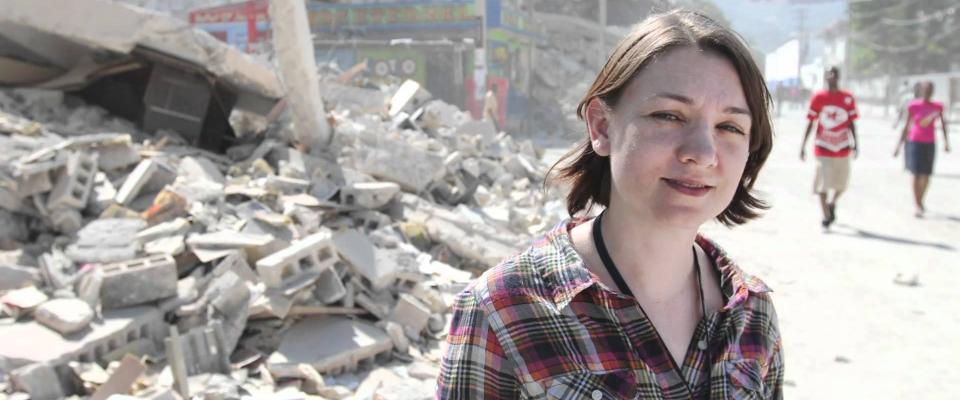Armstrong brings reporting chops and empathy to her new journalism teaching role.
This summer, after a nationwide search and interview process involving current students, the UC Berkeley Graduate School of Journalism announced the addition of two new faculty members: Lisa Armstrong, an award-winning reporter and associate journalism professor at City University of New York (CUNY), and Shereen Marisol Meraji, co-host and senior producer of NPR’s Code Switch. The two will teach courses on race and journalism as well as reporting.
The new hires come in response to an electronic uprising staged by students last June, amid a season of pandemic and protest. Weary from what they saw as the inequity in the department and a lack of empathy from their instructors, the outgoing class, led by Ashley Omoma ’20, dispatched emails detailing their experiences at the J-school. The passionate missives lit up computer screens of deans, faculty, administrators, students, and alumni.

“Since being at the J-school it is apparent that this institution is very much ok with enacting violence against its Black students, poor students and non-white students,” she wrote in a letter in the weeks following graduation. (Omoma uses “violence” in a very broad sense, to include non-physical actions and inactions experienced as harmful.)
“How can the J-school call out the violence committed by police onto Black bodies while ignoring acts of violence perpetrated against its own students? It is clear there is cognitive dissonance here and it needs to be taken seriously if the school wants to show it cares about the wellbeing of ALL its students.”
Omoma, who was deeply impacted by the killings of George Floyd, Breonna Taylor, and Ahmaud Arbery, drafted a list of 22 points calling out the school for what she felt was a lack of meaningful response to those events and larger systemic issues regarding race at the journalism school. Two points in particular gained traction with the administration, setting in motion a series of events: Omoma criticized the school for having no full-time Black faculty members and went on to write that “it is even more so violent” that the school didn’t hire “a Black person or person of color who actually studies race and journalism.”
Shortly after the students aired their grievances, Professor Edward Wasserman stepped down as dean months earlier than planned. Professor Geeta Anand became interim dean and eventually acting dean with the support of her peers and the J-school’s graduate student body.
A former foreign correspondent for the New York Times and the Wall Street Journal, Anand said she supported the students’ demands, which she saw as “a vehicle for transforming the school,” and cited her own background as a campus activist at Dartmouth “who took over the college president’s office with a group of students to demand divestment from companies doing business in South Africa.”
Lisa Armstrong, who started at Cal this summer, was born in New York to parents from Trinidad and Tobago. At three, she and her family moved to Kenya, where they lived for 12 years before relocating to Jamaica and eventually returning to the United States in time for Armstrong to attend university.
“I have all of these pieces from all over the world. So, on the one hand, I don’t necessarily fit in 100 percent anywhere…. I can adapt to different environments. I’m curious about different things.”
As a professor for more than a decade at the Craig Newmark Graduate School of Journalism at CUNY and a full-time faculty member there since 2017, Armstrong played a key role in the school’s equity and inclusion plan. Her work has also appeared in the Intercept, the New Yorker, Rolling Stone, HuffPost, and CBS News, and her reporting on Robert Taylor—who is serving a life-without-parole sentence for a crime committed at 16—was turned into a multimedia stage performance that premiered at Carnegie Hall in March 2019.
This summer, California intern and Berkeley J-school student Ande Richards met with Armstrong over Zoom to discuss her new role. The interview has been edited for clarity.
Many qualified people were vying for this position. What particular set of skills set you apart?
Lisa Armstrong: It’s tricky to say because I don’t know what others brought to the table. Still, I would say emotional intelligence or empathy. I am really concerned with students succeeding, not just in the classroom or even in the field but just overall, as people. Maybe you’re working or have a family and trying to get all of this stuff done. It can be stressful. I try to mentor folks and talk to them about stuff outside the day-to-day.
What is your approach to teaching race and journalism?
LA: [My approach] starts with the history and looks at how communities of color have been covered, then at how some of those practices are still in place now.
The Kerner Commission, which was commissioned in 1967 after the Detroit riot, stated in part: “When the white press does refer to Negroes and Negro problems it frequently does so as if Negroes were not a part of the audience. This is perhaps understandable in a system where whites edit and, to a large extent, write news. But such attitudes, in an area as sensitive and inflammatory as this, feed Negro alienation and intensify white prejudices.”
I’m sure people have been questioning these practices for decades, but it has become more pointed in recent years, both in terms of what I see from other working journalists and what I see from students.
We’re still getting narratives that lack nuance and context. I read an analysis of news coverage of the protests after George Floyd was killed that said that, while there were often details about rioting and looting, there wasn’t enough about the root reasons for the protests: police brutality and racism.
The Philadelphia Inquirer ran a headline, “Buildings Matter, Too,” playing off of “Black Lives Matter,” and the column was essentially about how unfortunate it was that protesters were destroying buildings. The headline was in poor taste because you’re essentially equating buildings with Black lives. (The Inquirer acknowledged this.) There are other examples of ways in which communities are, in my opinion, unfairly covered or misrepresented. An article in the New York Times a couple of years ago about the Inuit community played on a lot of the stereotypes of Indigenous people.
In reading stories about the recent assassination of the Haitian president, I’ve seen over and over that it’s “the poorest country in the western hemisphere,” when I know from my reporting there that there were systems put in place, including by the American government, that have left Haiti impoverished. So, it’s not as simple as saying that this country is “poor.”
I’m sure people have been questioning these practices for decades, but it has become more pointed in recent years, both in terms of what I see from other working journalists and what I see from students—what they’re demanding and how they think journalism should be.
Several major news stories highlighted racial inequity in the United States this year. Which stories do you feel were handled best, and which ones fell short?
LA: I think there was a mixed bag. If you look at the coverage of George Floyd’s murder—the coverage of the protests and how narratives developed, and the language was applied, like a “protest” versus a “riot”—how do we refer to what happened to George Floyd? How do we even describe that?
I had a conversation with other journalism professors about the coverage of the shooting of the people at the spa in Atlanta and whether you could use the term “hate crime.” And one professor was saying there’s a very strict legal definition of a hate crime. And, you know, there’s been reporting on the fact about why it’s challenging to get things labeled as hate crimes and the fact that often Asian Americans don’t report attacks. It’s not black-and-white.
The thing that I appreciated the most was the media analysis I saw; there was context on the coverage of their protests and the language that different outlets were using. So, I think we have a way to go in journalism, but there was an awareness.
Helping other instructors address diversity in their curriculum is part of your new role. What’s your road map for this?
LA: One of the things I said during the interview process is that we live in a country where race is built into everything. It’s something I think students need to be aware of. And, it’s not just race; it’s how we report on folks with disabilities, it’s how we report on LGBTQ+ communities. There are a lot of things that I think students need to be aware of.
“The journalism industry is changing. Journalism schools are changing—what we teach and how we teach. Whether we want to go on this journey or not, students are going to make us.”
If you’re a Black woman, you might not get paid as much as a white man. So there are all of these things that are at play in the industry. I also think it needs to be discussed early on because, hopefully, everyone’s done their homework before they applied to J-school, but you know, it’s a tough industry.
I’ve had several students of color who have been unable to find jobs after graduation, and some ultimately end up leaving journalism altogether. A few years ago, I did a survey of journalists of color and editors at several major outlets. The idea was in part to find out why these journalists were unable to move from being reporters into editing/managerial roles. The white editors I interviewed said they were looking for more diverse talent, but that when there was an opening, they tended to just go to the people in their circle—generally other white folks.
And here again, the journalists I interviewed expressed frustration that there was no way for them to advance in newsrooms.
And in terms of my own experience, because of what I cover—incarceration, and before that I was doing a lot of international reporting—I’ve mainly worked with white male editors, and that has been challenging at times.
The journalism industry is changing. Journalism schools are changing—what we teach and how we teach. Whether we want to go on this journey or not, students are going to make us. We all have things that we need to learn, and I think that as professors, we should always be learning and finding ways to do things better.
What will you miss the most about New York City, and what are you looking forward to the most here in the Bay Area?
LA: Where I live in Brooklyn, I can walk outside my door, and if I need a loaf of bread, I can walk to the corner. If I want to get my hair done, I can walk a block. I can walk to wherever I need to go. I live in an incredibly diverse neighborhood. My family is originally from the Caribbean, and I can get all kinds of Caribbean food and ingredients for meals.
I will miss my friends. I will miss the Newmark J-school because I’ve been there for a very long time.
What I’m looking forward to the most? I am looking forward to working with the folks at the [Berkeley] J-school. You know, one of the reasons that I took the job is that I could see that there was movement in the direction that I think journalism needs to be going. So I feel like I’m joining a team of people who are committed to similar goals.
I’m trying to prepare for the J-200 [Reporting the News] Oakland class. I’m not from Oakland, and I feel very strongly that I should know something and line things up. So I’ve been trying to find activists and people from organizations to talk about the work that they’re doing so that hopefully they can come and talk to the class.
I love teaching. And so the opportunity to collaborate with other people and offer something to the students is exciting.
It’s an adventure. It’s an opportunity to meet new people and work with new people.
Ande Richards is a second-year graduate student at the Berkeley J-school. She currently lives in South L.A. with her rescue pitbull Ralph and a thriving indoor succulent garden.
From the Fall 2021 issue of California.





















